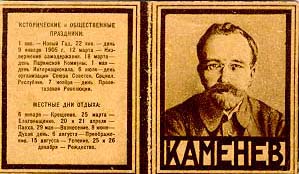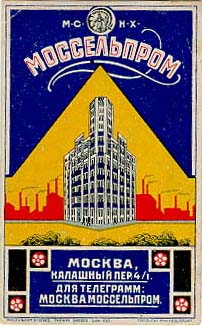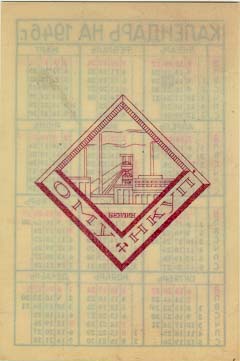FROM a HISTORY of SOVIET POCKET CALENDARS
by
Dmitry Maljawin
It should not be said that for the first years of the Soviet authority, that there were no calendars at all. Large table calendars of this time are available in some collections. However pocket calendars for the first years after the revolution are not yet known and most likely, they simply did not survive. Maybe in general they practically were not in circulation or issued. Only from 1923, did pocket calendars begin again to be actively printed.
It is necessary to note a rather strange fact,- pocket calendars of the NEP (new economic policy) period are practically unknown. This is very surprising, and inexplicable. It would seem, that advertising calendars of this period should exist, and be in numerous quantity and variety. But only one of these calenders from Petrograd is known.
The first pocket calendars issued by the Soviet authority, are known only from 1924. But already among calendars of this 1924 year, we see a unexpected variety of subjects. Here is political advertising, for example, in a series of calendars issued by the order of the goverment commission on children, there are portraits of the members of our Political Bureau in a circulation of 600.000 copies. The truth, about whether it was such a large series, is possible only to guess. Certainly, calendars with LeninÆs portrait were kept in great numbers and not only in private collections, but also in funds such as the State Public Library in Sankt-Peterburg. It is not surprising, that also were pocket calendars with portraits of high government officials such as KalininÆs, SemashkoÆs or DzedzinskyÆs service portrait . Strange, perhaps is the fact that pocket calendars with portraits of Stalin is unknown.  As to others, calendars from all large government structures from those years of the management authority of the country, only this portraits could safely be kept in ones home. In my collection there is by a miracle a kept copy with a portrait of Kameneff who was in opposition with Stalin. You see that it was possible to pay for the a storage or keeping of such a portrait by ones own life. But the calendar with a portrait of Trotsky is known in one of the Moscow collections.
As to others, calendars from all large government structures from those years of the management authority of the country, only this portraits could safely be kept in ones home. In my collection there is by a miracle a kept copy with a portrait of Kameneff who was in opposition with Stalin. You see that it was possible to pay for the a storage or keeping of such a portrait by ones own life. But the calendar with a portrait of Trotsky is known in one of the Moscow collections.
A calendar series of the Russian theatrical society for the same year 1924 with portraits of known actors are seldom found. Certainly, to keep a portrait of Davydoff or Baklanova was safe. But also circulation of these portraits was 20 times less. The epoch of calendars for trade advertising begins the same year. And, first with the Tobacco trust calendar with releases for 20 years that surpass the largest of all pocket calendar releases in Russia. But, now we know from the price-list of that time that domestic tobacco products were more rich and diverse than even at the present time.

A Calendar of "State Metric Office" on 1925 was issued to celebrate the transition of the country to the Metric system and contains a table of translation of old Russian measures into metric equivalents. Calendars of ETCR (Electrical Trust of the Central Russian Region) for 1925 and also already under the new name GET (State Electrotechnical Trust) for 1926, are perfectly executed and curious by how they reflect the initial stage of development of electrification in USSR.
Pocket calendars issued by Mosselprom (Moscow Agricultural Industry Office) are interesting for a creation having to do with known poet Majakovsky and artist Rodchenko.  These calendars and others very precisely depict the spirit of their time. They are executed in a style, known to us to represent a style of the twenties. A calendar of the Printing House of the Academy of Applied Arts in Leningrad was executed in the then fashionable style of Constructivism. The first pocket calendars of the foreign trade organizations are let out. For example, are the series of calendars "KaukazMinVodExport" from 1928 and the calendar of ōMezdunarodnaja Knigaö ("International Bookö) from 1929.
These calendars and others very precisely depict the spirit of their time. They are executed in a style, known to us to represent a style of the twenties. A calendar of the Printing House of the Academy of Applied Arts in Leningrad was executed in the then fashionable style of Constructivism. The first pocket calendars of the foreign trade organizations are let out. For example, are the series of calendars "KaukazMinVodExport" from 1928 and the calendar of ōMezdunarodnaja Knigaö ("International Bookö) from 1929.
Calendars of first half of thirties are meet less often. It is possible, that this is connected with the short-term experimental introduction in Russia of a new calendar system ¢ ōfive days systemö. This history is worthy of a separate story.
In 1936 in Leningrad was issued by the order of SOJUZSREDSPROS a calendar for 1937 which was the first domestic calendar on plastic.
The Second World war, which had fallen on our country, sharply reduced the release of calendars, as well as all another civil products. Calendars of war years are extremely few and generally not informative. Certainly this was not a time for calendars. But at the end of 1945 was printed a calendar by the publishing house "Art" on 1946 - calendar of Victory with salute, flags, and the hymn of the Soviet Union. Being an original relic, this calendar was one of the most kept calendars of the fourties. It is present practically in any serious collection.
Then in 1945, Soviet calendars begin to be printed in Germany.  An interesting example can be seen with calendars of the Ministry of the Coal Industry on 1946 printed in Berlin on multi-coloured celluloid. From the end of the fourties and up to the middle sixties, pocket calendars are not numerous. The State Insurance Company, State Savings bank, and Aerofleet were issuing calendars. If we add to these the annual releases of publishing house "Art", we shall find, probably 80 % of all calendars issued in that time.
An interesting example can be seen with calendars of the Ministry of the Coal Industry on 1946 printed in Berlin on multi-coloured celluloid. From the end of the fourties and up to the middle sixties, pocket calendars are not numerous. The State Insurance Company, State Savings bank, and Aerofleet were issuing calendars. If we add to these the annual releases of publishing house "Art", we shall find, probably 80 % of all calendars issued in that time.
Already since the end of the thirities, the artistic level of pocket calendars steadily is reduced. Industrial engineering in the country is worn out. As a consequence of censorship, calendars were made for hurrah, patriotism, neutral themes frequently reflecting no theme.
In the sixties among different releases are some distinguished by execution of the engineering being more important than taste. Pocket calendars of this kind ōViews of Leningradö were issued by the 3-d Leningrad Factory of Offset Printing.
From approximately 1961 to 1969 these releases used graphic figures of various rather known artists, such, as, for example, Ostroumova-Lebedeva.  For 10 years were issued more than 200 views including different colour variants.. Now these calendars, named by collectors "Leningrad Graphic", are the dream and pride of any collector. And, by the way, these calendars included fakes made especially for the collectors whose demand for them was so great.
For 10 years were issued more than 200 views including different colour variants.. Now these calendars, named by collectors "Leningrad Graphic", are the dream and pride of any collector. And, by the way, these calendars included fakes made especially for the collectors whose demand for them was so great.
In the middle sixties, advertising calendars for the foreign trade firms have begun to be ordered in other countries. At first it was East Germany and Hungary, and then Finland. Then later came Austria, Switzerland, Italy and Japan. Their quality was considerably higher.
Nevertheless from the begininning of the eighties, the release of pocket calendars is sharply increased and circulations grow. The number of the collectors in our country quickly grows. By 1990, almost at each regional centre were clubs of the collectors of pocket calendars. The general number of the collectors in the country achieved not less than one hundred thousand. Calendars begin to be printed specially for collectors, the subject or themes extends in view their tastes.
There was censorship untill 1990 in the country. Any printed material no matter where or by whom issued had to receive the sanction of the censor. The number of this sanction (so-called "lit") was printed in the target data alongside the number of the order. (Sometimes, when the large series of calendars passed under the same order, frequently "lit" helps the collector in ordering his collections.) But now such restrictions enable collectors to catalogue practically all Soviet calendars.
In December, 1991 the Soviet Union ceased to exhist. However calendars on 1992 were ordered in 1991, and, therefore, for the most part, it is possible to consider them as calendars of the Soviet period. In this time were still kept pan union connections, so, for example, overwhelming numbers of the Lithuanian calendars on 1992 are printed in the Russian city of Tula, and almost half of Estonian calendars of 1992 were issued with the idea of selling them in the territory of Russia. Nevertheless, calendars of the 1990-1992 years already were calendars of a transition period.
Since 1992, all former USSR republics began to issue only their own calendars on their own national languages. The Soviet period was over. The changes touched all of the parties of life, including pocket calendars.
Return

 As to others, calendars from all large government structures from those years of the management authority of the country, only this portraits could safely be kept in ones home. In my collection there is by a miracle a kept copy with a portrait of Kameneff who was in opposition with Stalin. You see that it was possible to pay for the a storage or keeping of such a portrait by ones own life. But the calendar with a portrait of Trotsky is known in one of the Moscow collections.
As to others, calendars from all large government structures from those years of the management authority of the country, only this portraits could safely be kept in ones home. In my collection there is by a miracle a kept copy with a portrait of Kameneff who was in opposition with Stalin. You see that it was possible to pay for the a storage or keeping of such a portrait by ones own life. But the calendar with a portrait of Trotsky is known in one of the Moscow collections.
 These calendars and others very precisely depict the spirit of their time. They are executed in a style, known to us to represent a style of the twenties. A calendar of the Printing House of the Academy of Applied Arts in Leningrad was executed in the then fashionable style of Constructivism. The first pocket calendars of the foreign trade organizations are let out. For example, are the series of calendars "KaukazMinVodExport" from 1928 and the calendar of ōMezdunarodnaja Knigaö ("International Bookö) from 1929.
These calendars and others very precisely depict the spirit of their time. They are executed in a style, known to us to represent a style of the twenties. A calendar of the Printing House of the Academy of Applied Arts in Leningrad was executed in the then fashionable style of Constructivism. The first pocket calendars of the foreign trade organizations are let out. For example, are the series of calendars "KaukazMinVodExport" from 1928 and the calendar of ōMezdunarodnaja Knigaö ("International Bookö) from 1929. An interesting example can be seen with calendars of the Ministry of the Coal Industry on 1946 printed in Berlin on multi-coloured celluloid. From the end of the fourties and up to the middle sixties, pocket calendars are not numerous. The State Insurance Company, State Savings bank, and Aerofleet were issuing calendars. If we add to these the annual releases of publishing house "Art", we shall find, probably 80 % of all calendars issued in that time.
An interesting example can be seen with calendars of the Ministry of the Coal Industry on 1946 printed in Berlin on multi-coloured celluloid. From the end of the fourties and up to the middle sixties, pocket calendars are not numerous. The State Insurance Company, State Savings bank, and Aerofleet were issuing calendars. If we add to these the annual releases of publishing house "Art", we shall find, probably 80 % of all calendars issued in that time. For 10 years were issued more than 200 views including different colour variants.. Now these calendars, named by collectors "Leningrad Graphic", are the dream and pride of any collector. And, by the way, these calendars included fakes made especially for the collectors whose demand for them was so great.
For 10 years were issued more than 200 views including different colour variants.. Now these calendars, named by collectors "Leningrad Graphic", are the dream and pride of any collector. And, by the way, these calendars included fakes made especially for the collectors whose demand for them was so great.